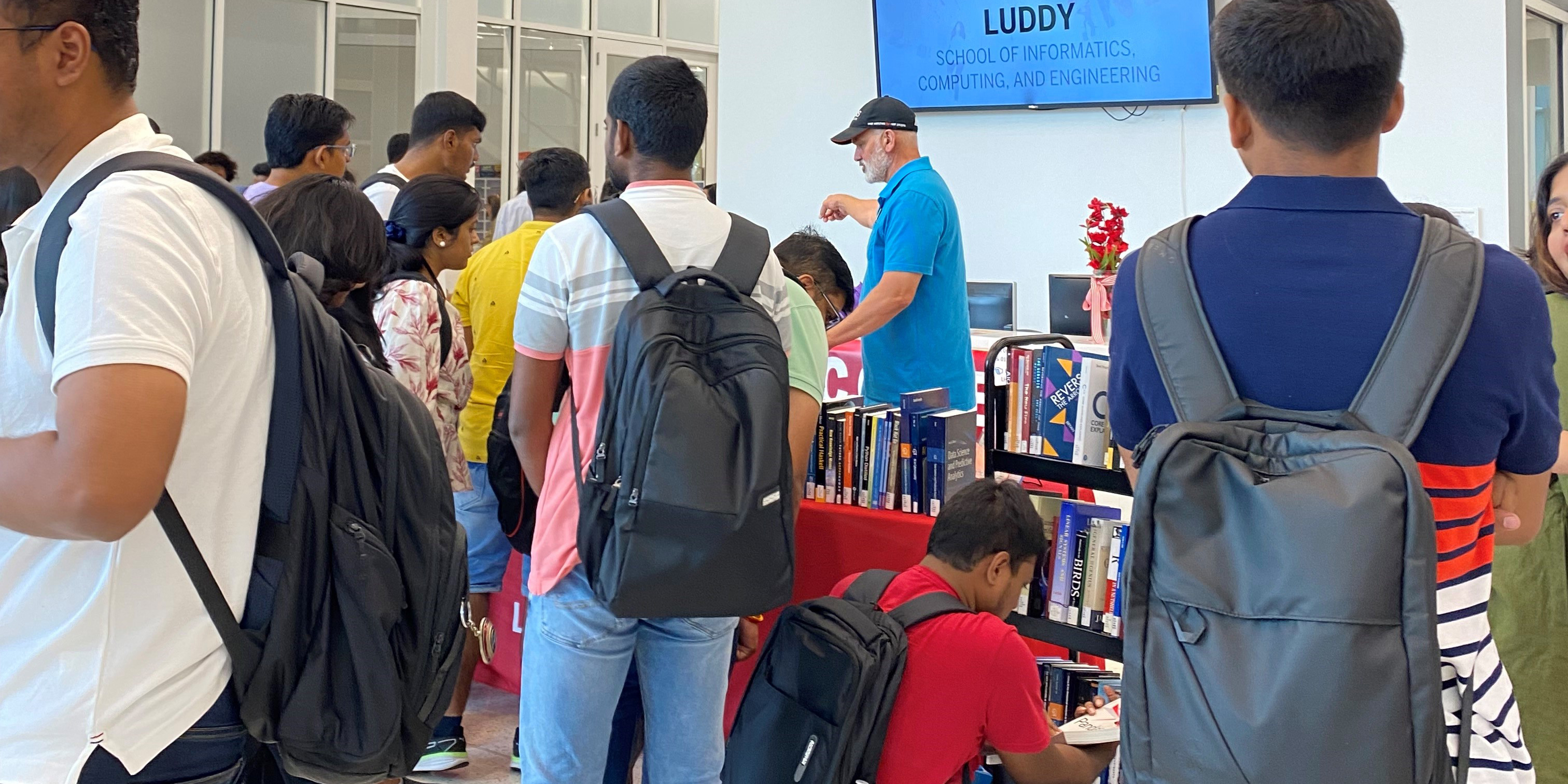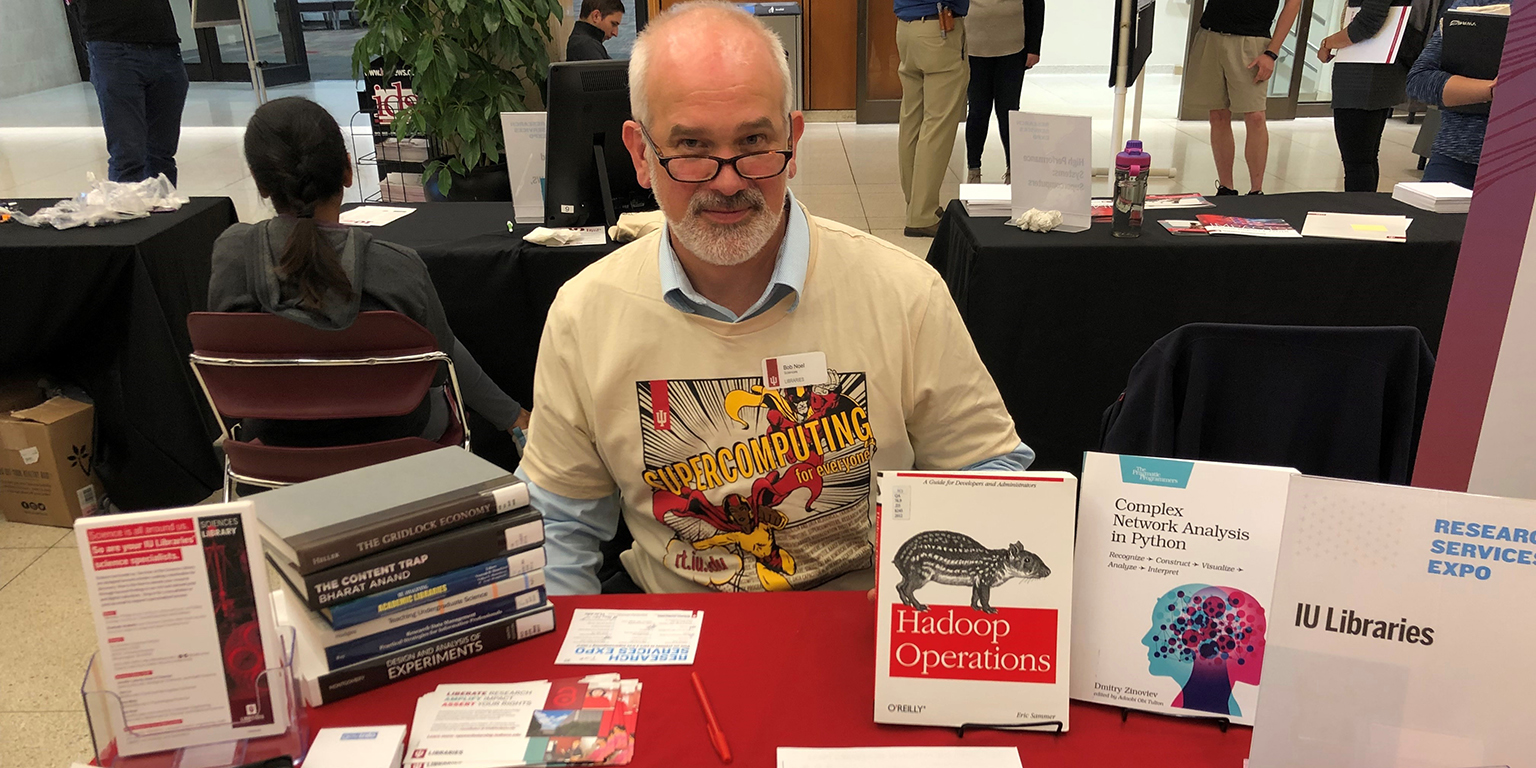Bob Noel
Associate Librarian,
Sciences Library
For almost 25 years, Bob Noel has worked with students and faculty in the Astronomy, Mathematics and Physics departments, as well as the Luddy School, as a collection manager and library liaison.
Bob Noel
Associate Librarian,
Sciences Library
For almost 25 years, Bob Noel has worked with students and faculty in the Astronomy, Mathematics and Physics departments, as well as the Luddy School, as a collection manager and library liaison.

With interests ranging from bibliometrics and faculty impact to the open access movement and the development and growth of the Creative Commons, Bob’s projects have included tracking faculty publications and analyzing syllabi as they relate with major news trends. He has been active with the Indiana University Librarians’ Association, served on the Library Advisory Board for Taylor & Francis Digital Products, and recently stepped down as a co-chair of the Luddy Alumni Ambassadors Board, a group dedicated to keeping recent graduates engaged with IU.
Bob earned his Master of Library Science and Bachelor of Arts in Philosophy degrees at IU Bloomington. Before rejoining IU as a librarian, he held positions at the Argonne and Oak Ridge national laboratories.
As we approach the eclipse, is there any reading you would recommend for those looking to best appreciate the phenomenon?
There is one recent addition to the IU Libraries that seems timely, and that is “Celebrating the 2017 Great American Eclipse: lessons learned from the path of totality”. This is a collection of essays and short pieces covering the eclipse from six years ago. It is an e-book, so we can all have a look at it without making a trip to the library.
The other thing I like to do is open the HathiTrust and have a look at some of the full-text astronomical reports covering eclipses from decades and centuries ago. For those unfamiliar with Hathi, this is a project that started roughly 15 years ago, and it is one of the largest digital repositories in the world, containing over 18 million items. It is a great online environment to view science, literature, periodicals, and all sorts of materials from the 18th and 19th centuries.

The Indiana University Librarians’ Association Book Sale is coming up on April 6. What can attendees expect, and what do you most appreciate about this event?
This year’s annual book sale will be one of the largest in recent years. The number of donations that came to the Wells Library has been quite large, as we have recently run out of storage space for current donations. IU’s American Indian Studies Research Institute contacted us with a significant number of books and government documents covering North American indigenous populations over the past 150 years. Visitors can expect thousands of used books from all subject areas priced to move; most materials are sold for $1 or less.
Proceeds from the InULA sale help us sponsor programs and workshops, publish a newsletter, award scholarships in the field of library and information science, and it provides grants to support the research and continuing education of InULA members. This year, our sale coincides with the campus’s ScienceFest, and it is only 48 hours prior to the eclipse, so we’re expecting the foot traffic near Wells Library (the sale is in room E-174) to be higher than usual.
Check out the Lilly Library’s Receding Horizons exhibit
What is something people might not know about the work of a science librarian?
One thing people may not be aware of is the fact that the science librarians (and most other IU librarians) are becoming much more proactive and mobile when it comes to showcasing our collections and new materials. In recent years, we have been regularly staffing “pop-up libraries” across campus; these will often accompany a visitor’s talk, a campus event, or will focus on a particular theme. It is an opportunity for us to bring new and relevant materials out to the schools and departments that may no longer have a departmental library.
My most recent pop-up library was in February of this year in Luddy Hall, and it was during National Engineering Week. We assembled our most recent acquisitions on artificial intelligence, data science, cybersecurity, and intelligent systems engineering. Junior faculty and graduate students in particular find these to be a convenient resource throughout the semester, as they can spot and check-out things they may have otherwise missed.

As a native Hoosier, is there anyone at IU, or any other Hoosiers you really admire?
Yes, there are a couple. The first is IU emeritus philosophy professor Paul Spade. This is an instructor who was able to take stuffy, difficult texts from the 19th and early 20th centuries, material packed with rambling scholastic verbiage, and interpret then present it to undergraduates in creative and entertaining ways. He is a great lecturer.
The other is former Earlham philosophy professor Peter Suber. He has been a champion of the open access movement, and has written and lectured extensively on these topics, and related ideas, such as the hazards predatory publishers pose. He’s currently a Senior Advisor on Open Access at Harvard’s Widener Library.
What is one of your favorite spots on campus? In Bloomington?
One of my favorite spots on campus is the first-floor west lounge in the IMU that has the fireplace and piano. This is just outside the large Starbucks in the Union, and it seems to be one of the great spots on campus for students to study or relax between classes. The other thing I like about this lounge is it used to be the one location on campus where students could find a print copy of their hometown newspaper (if they happened to be from Indiana). This practice discontinued over thirty years ago (partly because small town newspapers have folded over the years), but I always thought that was a great idea for that central location.
One of my favorite Bloomington spots is Griffey Lake – it’s a great place to hike, and if you’re lucky, you can spot all sorts of wildlife out there.
